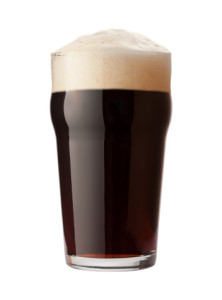
English Stout Beer
If you’ve heard of nitrogenated beer – also known as nitrogen beer or nitro beer – it’s referring to the type of gas dissolved in the beer to create bubbles. Typically beers are carbonated with carbon dioxide (CO2). Dissolving nitrogen into beer makes a few key differences in the foam, feel, and flavor of the final product. If you’re interested in learning more about nitrogen beer, let this blog be your guide.
Where Does Nitrogen Beer Come From?
The preferred serving style of English Ales is comparatively warm and flat because they were developed before refrigeration. Traditionally, cask-conditioned English ales were served with a hand pump, or “beer engine” which pumped air into the barrel and pushed it up to tap faucets upstairs in the bar. Air is about 78% nitrogen. (Unfortunately, the air pump also introduced oxygen into the beer, which makes up 21% of air, and oxidizes the beer.)
Nitrogenation helps brewers recreate the smooth feel and thick head of cask ales. The low level of carbonation pairs well with a higher content of malt and hops. Many drinkers find the tiny, creamy bubbles nitrogen makes to be delicious.
Another famous nitrogenated beer comes from Guinness. Guinness was the first brewery to patent a design for a nitrogenated keg in 1932. It’s an Irish dry stout known for its sharp lactic flavor and thick, creamy head.
What’s the Difference?
American beers are served cold and highly carbonated. Some carbon dioxide gets into the beer naturally during the fermentation process, but the cold temperature keeps the added carbonation from escaping. The CO2 brings out the flavor of the existing ingredients. That’s why it’s typically brewed lighter – that is with fewer of the key ingredients of malt and hops. Nitrogenated beers are much heavier on malt and hops.
How Do Carbonation and Nitrogenation Affect Flavor?
When CO2 dissolves in your drink, it makes it more acidic, which creates a somewhat sour taste. Carbonated beverages also create a slight tingling sensation on your tongue which is processed by pain receptors, but translates as a flavor.
Nitrogenated beers have significantly smaller bubbles and more stable foam. This dramatically changes the “mouth feel” significantly, as well as flavor. Nitrogenated beers also tend to be less bubbly because nitrogen doesn’t dissolve as much as carbon dioxide at the same pressure. Overall they have a thick smooth feel compared with the fizzy and tingly bubbles made by carbonation.
Nitrogen Generators
Getting nitrogen into beer used to be a difficult and potentially hazardous process. To make the size of deliveries smaller, nitrogen was liquefied at −346 °F and stored in heavy cylinders that tended to leak during the delivering and unloading process – wasting resources and potentially injuring workers by exposure. Nitrogen generators are a safe, economical source for ultra-pure nitrogen. They automatically eliminate much of the waste associated with older nitrogenation methods.
Read more about the economic benefits of nitrogen generators and their technical capabilities. Contact us Clean Beer you’re interested in purchasing a nitrogen generator from us for your home or bar.
